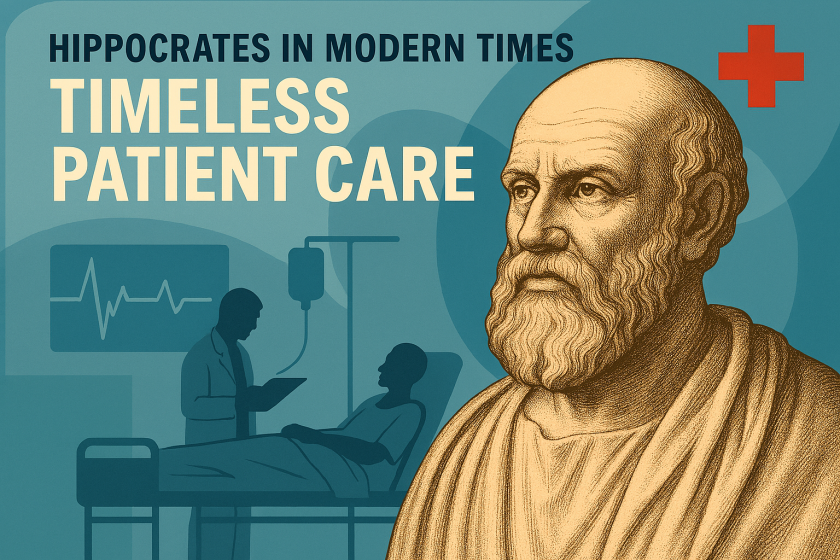
Hippocrates in Modern Time: Timeless Patient Care
Good people get defeated by a bad system. It’s a frustrating reality in healthcare that leads to inferior outcomes and burnout. While we seek solutions in new technology and processes, sometimes the most powerful innovations are principles that have stood the test of time. The wisdom of Hippocrates, dating back over two millennia, offers a powerful framework for enhancing patient care and navigating the complexities of modern medicine.
These ancient principles are not merely historical footnotes; they are a blueprint for building trust, improving outcomes, and leading change. By revisiting concepts like holistic care and empathetic communication, we can find solutions to persistent challenges, from patient mistrust to professional fatigue.
This post will explore key Hippocratic principles and their direct application in today’s clinical environment. We will cover:
- The foundational rule of “First, Do No Harm” in a complex system.
- Applying holistic care beyond physical symptoms.
- Using empathy and communication to address misinformation.
- Fostering collaboration to improve patient outcomes.
“First, Do No Harm”: Beyond the Physical
The principle of primum non nocere, or “First, Do No Harm,” is the cornerstone of medical ethics. In its most direct sense, it guides clinical decisions to prevent physical harm. However, its application in modern healthcare extends far beyond the procedural. Harm can also be psychological, emotional, or systemic.
Consider a patient who feels dismissed or unheard. While their physical treatment may be sound, the emotional harm caused by a poor interaction can erode trust and impact their willingness to follow care plans. This is where the system often fails patients and clinicians alike. High patient loads and administrative burdens make it difficult to provide the focused, empathetic attention that true healing requires.
Applying this principle today means:
- Leading with Empathy: Acknowledging a patient’s fears or perspective, even if it contradicts clinical findings, prevents the harm of alienation. A simple phrase like, “I can see why that would be concerning,” builds a bridge rather than a wall.
- Protecting Patient Dignity: Ensuring privacy, clear communication, and respect throughout the care journey is a critical part of avoiding harm.
- Considering Systemic Impact: As clinical leaders, we must also consider how processes and workflows impact patient well-being. An inefficient system that creates stress and confusion is, in itself, a form of harm.
Holistic Care: Treating the Person, Not Just the Condition
Hippocrates championed the idea of treating the whole person, looking at their environment, lifestyle, and emotional state. This holistic approach can feel like a luxury in a system geared toward specialisation and rapid patient turnover. Yet, it is more critical than ever.
A patient is more than a set of symptoms or a diagnosis code. A chronic condition may be exacerbated by stress at home, a lack of social support, or financial anxiety. Ignoring these factors leads to incomplete care and contributes to the cycle of readmissions and poor outcomes.
Here’s how to reintegrate a holistic approach:
- Explore the “Why”: Take a moment to understand the patient’s context. Ask about their work, their family, and their biggest stressors. This information is not incidental; it is vital data for effective treatment.
- Foster Interdisciplinary Collaboration: A truly holistic view requires teamwork. Engaging social workers, mental health professionals, and pharmacists creates a comprehensive care plan that addresses the patient’s full spectrum of needs. This is a core component of driving patient-centred innovation.
- Address Emotional Roots: Passionately held but incorrect beliefs often stem from fear or a search for control. Before presenting facts, understand the emotion behind the belief. This aligns with a holistic view of the patient as an emotional and psychological being, not just a physical one.
The Art of Communication: Bridging Emotion and Evidence
Hippocrates understood that a physician’s ability to communicate was as important as their clinical knowledge. Today, we face a deluge of misinformation that makes clear, trusted communication a primary challenge. When a patient arrives with deeply held beliefs sourced from social media or unreliable websites, presenting a stack of clinical studies is often ineffective.
This is where the “art” of communication comes in. It requires moving beyond data dumps and connecting on a human level.
Strategies for masterful communication include:
- Using Storytelling: A relatable analogy or a short, anonymised story of another patient’s success can be far more persuasive than statistics. Narratives help bridge the gap between abstract data and real-world impact, making evidence feel more tangible and trustworthy.
- Establishing a Shared Goal: Frame the conversation not as a debate to be won, but as a collaboration. The goal is not to prove the patient wrong but to work together for the best possible health outcome. This shifts the dynamic from confrontational to cooperative.
- Presenting Evidence Gently: After establishing an empathetic connection, introduce data as a helpful tool. Frame it as, “Here is some information that has helped others in your situation,” rather than, “Your belief is incorrect, and here’s why.”
Leading the Future with Timeless Wisdom
The principles of Hippocrates are not relics of the past. They are a call to action for modern healthcare leaders. They remind us that at the heart of our complex, technology-driven system is a fundamental human interaction.
By embedding empathy, holistic understanding, and masterful communication into our daily practice and the systems we design, we can combat burnout, improve patient loyalty, and achieve superior outcomes. These principles empower us to lead change, not by chasing the next trend, but by returning to the core of what it means to care for another person.
The challenge is to build a system that supports this humanistic approach, reducing the administrative waste that prevents good people from doing their best work. By championing these timeless values, we can drive patient-centred innovation and create a healthcare environment that truly heals.




